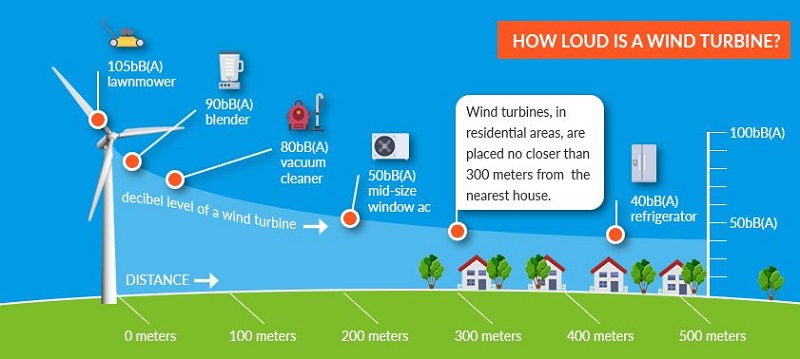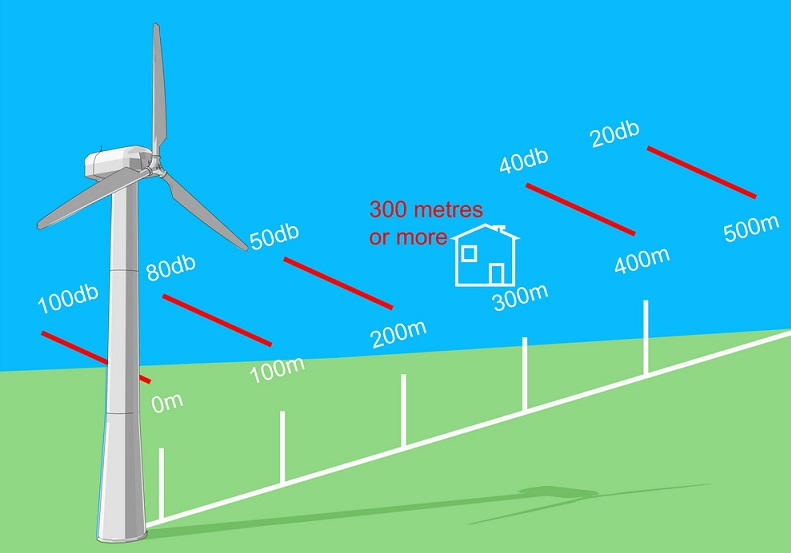What Sounds Do Turbines Make?
Modern low RPM (Revolutions Per Minute) turbines are very quiet, with sound levels usually below that of typical ambient noise in the home. Wind turbine sounds come from two primary sources, mechanical and aerodynamic. As with many technologies, there have been substantial improvements over time. Noise reduction often coincides with increases in turbine efficiency, so industry has been particularly motivated to make these improvements. Measured sound levels from wind turbines depend on several factors, including weather conditions, the number of turbines, turbine layout, local topography, the particular turbine being used, distance between the turbines and the listener, local vegetation, and the time of day and time of year. As noted above wind power and thus wind turbine noise tends to be greater at night and in the winter.
Mechanical sounds originate from the various moving parts within the wind turbine: the generator, the hydraulic systems, and the gearbox. The sound is associated with the rotation of mechanical and electrical equipment as it produces electricity. Strategies to mitigate these mechanical sounds including suppression and isolation of vibration and fault detection are commonly used in modern turbines. In turbines using these strategies, mechanical noise is not generally audible above the aerodynamic noise of the blades or the ambient noise in the environment other than during the brief application of mechanical brakes.

Aerodynamic noise is associated with the movement of the blades through the air. This is the dominant source of audible noise from wind turbines. However, these aerodynamic sounds can often be masked, at least in part, by other sources of ambient noise such as wind blowing through the trees or over houses, the movement of nearby cars and trucks on the road, or other sounds in the home like the compressor on a refrigerator or the blower fan of a furnace.
Aerodynamic sound generally increases with the rotational speed of the blades when turbulence in the air layers near the blades is more strongly generated. Strategies for reducing aerodynamic noise include adaptive approaches and wind turbine blade modification methods. While the aerodynamic sounds associated with turbine blades are complex, two types of sound—“swooshing" and "low frequency"— are the most commonly discussed. The swooshing effect is caused by the blade tip passing through the air and its changing distance from the observer as it rotates. Environmental factors including wind speed variations in space, thermal inversions and other meteorological effects, the presence of other wind turbines, and the topography of the site, may interact to modulate the swooshing sound into what is described as a thumping sound, but
this thumping (more formally known as impulsive sound) is an unusual occurrence that is often transient, disappearing when the particular set of circumstances that created it pass. For example, a study by the University of Salford concluded that of 155 wind farm sites surveyed, only four exhibited instances of impulsive noise generation and at those sites, impulsive noise occurred 7-15 percent of the time and was able to be mitigated by changes in how the turbines were operated.
Modern turbines employ a number of advanced blade design features that significantly reduce aerodynamic noise. For example, changes to blade designs have been found that can reduce the power intensity of audible sound from wind turbines by as much as half.

In addition to mechanical and aerodynamic sounds, wind turbines can also produce low frequency sound and inaudible vibrations called infrasound. Low frequency sound contains frequencies in the range 20 to 100 Hz and is primarily associated with the operation of older turbine designs that had the rotor downwind of the tower. The low frequency sound in these turbine designs was caused when the blades encountered localized disturbances in the wind that had first passed around the tower. This style of turbine is no longer common.
Infrasound is sound with frequencies below 20 Hz. Infrasound may be generated, at least in part, by turbulence in the air interacting with the leading edge of the blade, but it is more likely caused by small variations in the flow of air over the blade as it passes in front of the tower. The sources of infrasound in modern turbines are yet to be fully explained. However, measurements of sounds emitted by operating utility-scale wind turbines (low-frequency sound, infrasound, tonal sound emission, and amplitude-modulated sound) have found that the intensity of infrasound at a distance of 300 m (984 feet) from homes are well below audibility thresholds.
Mechanical sounds originate from the various moving parts within the wind turbine: the generator, the hydraulic systems, and the gearbox. The sound is associated with the rotation of mechanical and electrical equipment as it produces electricity. Strategies to mitigate these mechanical sounds including suppression and isolation of vibration and fault detection are commonly used in modern turbines. In turbines using these strategies, mechanical noise is not generally audible above the aerodynamic noise of the blades or the ambient noise in the environment other than during the brief application of mechanical brakes.

Aerodynamic noise is associated with the movement of the blades through the air. This is the dominant source of audible noise from wind turbines. However, these aerodynamic sounds can often be masked, at least in part, by other sources of ambient noise such as wind blowing through the trees or over houses, the movement of nearby cars and trucks on the road, or other sounds in the home like the compressor on a refrigerator or the blower fan of a furnace.
Aerodynamic sound generally increases with the rotational speed of the blades when turbulence in the air layers near the blades is more strongly generated. Strategies for reducing aerodynamic noise include adaptive approaches and wind turbine blade modification methods. While the aerodynamic sounds associated with turbine blades are complex, two types of sound—“swooshing" and "low frequency"— are the most commonly discussed. The swooshing effect is caused by the blade tip passing through the air and its changing distance from the observer as it rotates. Environmental factors including wind speed variations in space, thermal inversions and other meteorological effects, the presence of other wind turbines, and the topography of the site, may interact to modulate the swooshing sound into what is described as a thumping sound, but
this thumping (more formally known as impulsive sound) is an unusual occurrence that is often transient, disappearing when the particular set of circumstances that created it pass. For example, a study by the University of Salford concluded that of 155 wind farm sites surveyed, only four exhibited instances of impulsive noise generation and at those sites, impulsive noise occurred 7-15 percent of the time and was able to be mitigated by changes in how the turbines were operated.
Modern turbines employ a number of advanced blade design features that significantly reduce aerodynamic noise. For example, changes to blade designs have been found that can reduce the power intensity of audible sound from wind turbines by as much as half.

In addition to mechanical and aerodynamic sounds, wind turbines can also produce low frequency sound and inaudible vibrations called infrasound. Low frequency sound contains frequencies in the range 20 to 100 Hz and is primarily associated with the operation of older turbine designs that had the rotor downwind of the tower. The low frequency sound in these turbine designs was caused when the blades encountered localized disturbances in the wind that had first passed around the tower. This style of turbine is no longer common.
Infrasound is sound with frequencies below 20 Hz. Infrasound may be generated, at least in part, by turbulence in the air interacting with the leading edge of the blade, but it is more likely caused by small variations in the flow of air over the blade as it passes in front of the tower. The sources of infrasound in modern turbines are yet to be fully explained. However, measurements of sounds emitted by operating utility-scale wind turbines (low-frequency sound, infrasound, tonal sound emission, and amplitude-modulated sound) have found that the intensity of infrasound at a distance of 300 m (984 feet) from homes are well below audibility thresholds.
Post a Comment:
You may also like:

Featured Articles
How Much Energy Will Wind Turbine ...
 According to the AWEA Small Wind Turbine Performance and Safety Standard, the Rated Annual Energy of a wind turbine for ...
According to the AWEA Small Wind Turbine Performance and Safety Standard, the Rated Annual Energy of a wind turbine for ...
 According to the AWEA Small Wind Turbine Performance and Safety Standard, the Rated Annual Energy of a wind turbine for ...
According to the AWEA Small Wind Turbine Performance and Safety Standard, the Rated Annual Energy of a wind turbine for ...How do Wind Turbines Work?
 Wind turbines generate electrical power in the same way as all other generation technologies. The only difference is in the ...
Wind turbines generate electrical power in the same way as all other generation technologies. The only difference is in the ...
 Wind turbines generate electrical power in the same way as all other generation technologies. The only difference is in the ...
Wind turbines generate electrical power in the same way as all other generation technologies. The only difference is in the ...Is Wind Energy Practical for Me?
 Can I use wind energy to power my home? More people across the country are asking this question as they look for a hedge ...
Can I use wind energy to power my home? More people across the country are asking this question as they look for a hedge ...
 Can I use wind energy to power my home? More people across the country are asking this question as they look for a hedge ...
Can I use wind energy to power my home? More people across the country are asking this question as they look for a hedge ...Does the Sound of Wind Turbines Affect ...
 With respect to wind turbine noise, the one adverse impact that is supported by epidemiological data is an association between ...
With respect to wind turbine noise, the one adverse impact that is supported by epidemiological data is an association between ...
 With respect to wind turbine noise, the one adverse impact that is supported by epidemiological data is an association between ...
With respect to wind turbine noise, the one adverse impact that is supported by epidemiological data is an association between ...What Sounds Do Turbines Make?
 Modern low RPM (Revolutions Per Minute) turbines are very quiet, with sound levels usually below that of typical ambient noise in ...
Modern low RPM (Revolutions Per Minute) turbines are very quiet, with sound levels usually below that of typical ambient noise in ...
 Modern low RPM (Revolutions Per Minute) turbines are very quiet, with sound levels usually below that of typical ambient noise in ...
Modern low RPM (Revolutions Per Minute) turbines are very quiet, with sound levels usually below that of typical ambient noise in ...